#casual islamic dressing style
Explore tagged Tumblr posts
Text
Discover the Beauty of Pakistani Suits A Guide to Islamic Fashion

Looking for stylish and modest clothing options? Pakistani suits, also known as salwar kameez, offer a perfect blend of tradition and modernity. These versatile ensembles are not only comfortable but also reflect the beauty of Islamic fashion. Let's explore some simple yet elegant Pakistani suit designs that cater to various styles and occasions.
Traditional Muslim Dress Timeless Elegance Traditional Pakistani suits often feature intricate embroidery, delicate embellishments, and vibrant colors. These designs showcase the rich heritage of Islamic fashion. However, if you prefer a more understated look, opt for simple suits with subtle details or plain fabrics. A classic combination of a solid-colored kameez with embroidered salwar or churidar pants can create a timeless and elegant ensemble.

Casual Islamic Dressing Style Everyday Comfort For everyday wear, casual Islamic dressing styles offer comfort and practicality. Consider Pakistani suits made from lightweight fabrics like cotton or linen, which are perfect for warmer weather. Simple designs with minimal embellishments or block colors can provide a relaxed and stylish look. Pair your suit with comfortable footwear like sandals or sneakers to complete the casual ensemble.
Salwar Kameez Black Dress Pakistani Simple A black salwar kameez is a versatile and timeless piece that can be dressed up or down. Choose a simple design with minimal embellishments to create a classic and elegant look. Pair it with matching or contrasting salwar or churidar pants for a polished appearance. Accessorize with a scarf, jewelry, or a stylish bag to add your personal touch.
Modern Pakistani Suit Design: Contemporary Chic If you're looking for a more contemporary look, modern Pakistani suit designs offer a fusion of tradition and modernity. Explore suits with unique cuts, asymmetrical hems, or bold color combinations. Experiment with different fabrics like velvet, satin, or chiffon to add a touch of luxury. Remember to choose designs that align with your personal style and comfort level.
In conclusion, Pakistani suits offer a wide range of options for women seeking stylish and modest clothing. Whether you prefer traditional designs or modern interpretations, these versatile ensembles can be tailored to suit your individual style and preferences. By embracing the beauty of Islamic fashion, you can create elegant and comfortable outfits that reflect your faith and personality.
#simple pakistani suit design#traditional muslim dress#casual islamic dressing style#salwar kameez black dress pakistani simple#modern pakistani suit design
5 notes
·
View notes
Text
saying F U to the regime again and again: a quick update on women vs IR regime
Famous Iranian actresses have been appearing in public without a mandatory hijab. This has been happening since the beginning of the protests. Last month, Kiumars Pourahmad, a well known Iranian screenwriter and director, committed suicide. He had a history of criticizing the regime's political decisions. At his funeral, some of the famous actresses attended without mandatory hijab.

You can see Fateme Motamedarya, Katayoun Riyahi, and Golab Adineh in these pictures from the funeral. Ms. Riyahi was one of the first celebrities who took her hijab off at the start of the Jina (Mahsa) Amini protest and for that she's been the target of IRGC harassment and has been to court.
Last week, in the ceremony of screening of the final episode of Lion's Skin (a persian crime show), actress Pantea Bahram participated without hijab. The manager of Tehran’s Lotus Cinema, where the ceremony was held, was fired for letting her attend without hijab.
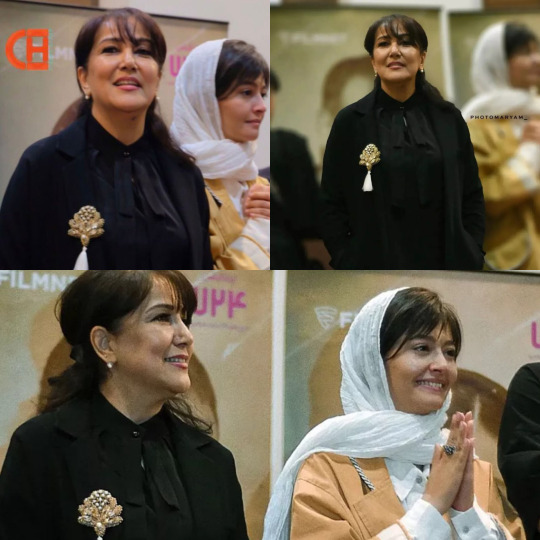
Other than prosecution, the regime has blocked these celebrities' bank accounts. Basij and IRGC members have also attacked and harassed these women online and in real life.
Students on university campuses take off their hijabs. There's an installed version of morality police in universities that monitor students' styles. Female students must wear "appropriate" hijab and male students must wear "manly" clothes (one of my guy friends once was asked to go back home and change his shoes because they were red casual loafers. Apparently that's gay!). When you enroll in Iranian universities, the first thing you do is to go to the security office and sign an agreement that says you promise to follow the Islamic dress code. There are posters all over the campus that says things like "hijab is security" "respect the islamic hijab" and "not wearing appropriate hijab (tight short clothes, too much hair, makeup, etc) would result in legal action". So not wearing hijab on campus, where a lot of security cameras are installed and it's easy to identify you, is a big deal.
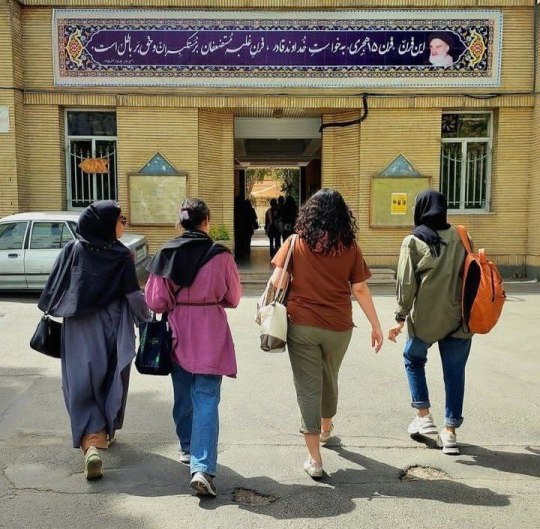
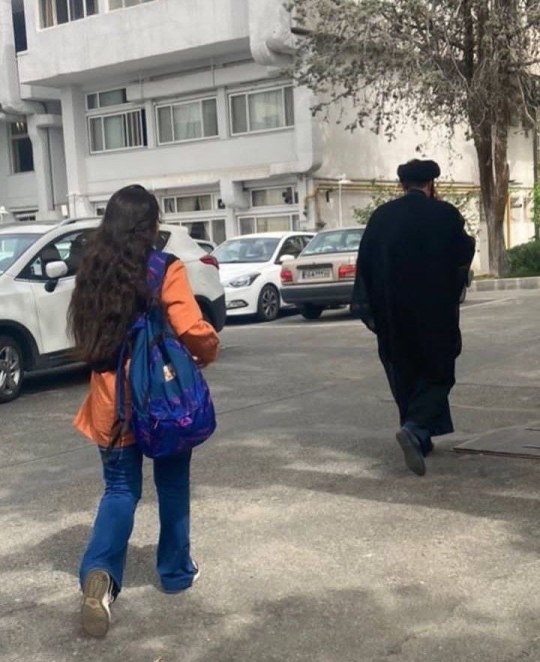
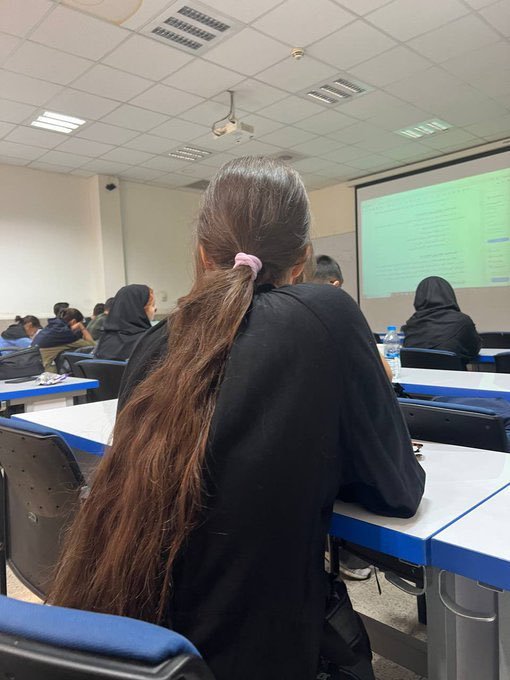
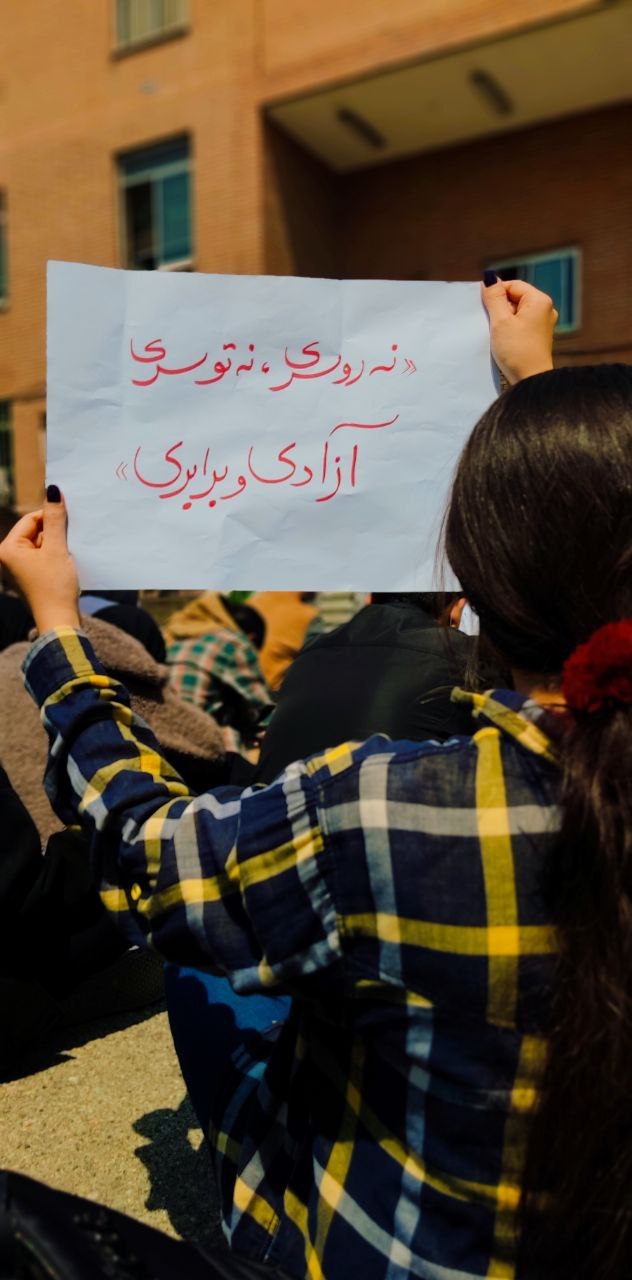



The regime's response to students taking off their hijabs is sending threatening messages to students' phones and increasing the security people. At the entrance of Universities, these security forces check people's clothes and if it's not proper they won't let you in. Some of the students wear the hijab at the entrance and take it off after they're in. They have warned our professors to not let non hijabi students sit in classes too.
One of my favorite trends in Iran now is when guys wear our hijab. These pictures are from universities. Guys wearing hijab make the security mad. This is a great act of solidarity with women against the obligatory hijab.
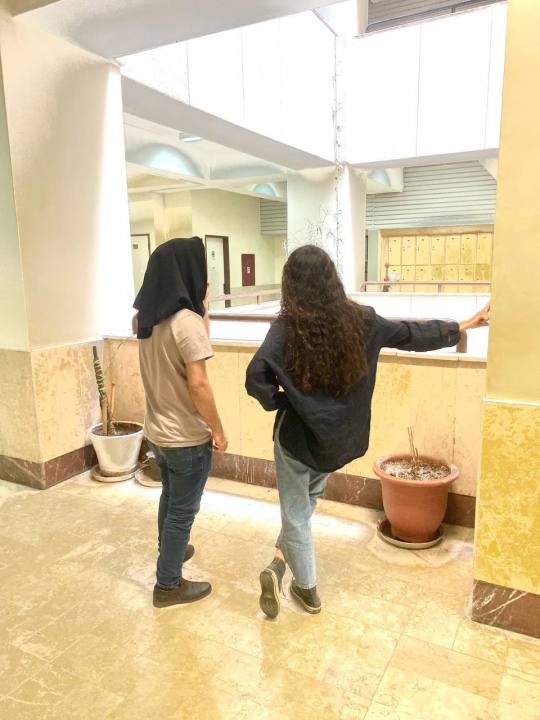

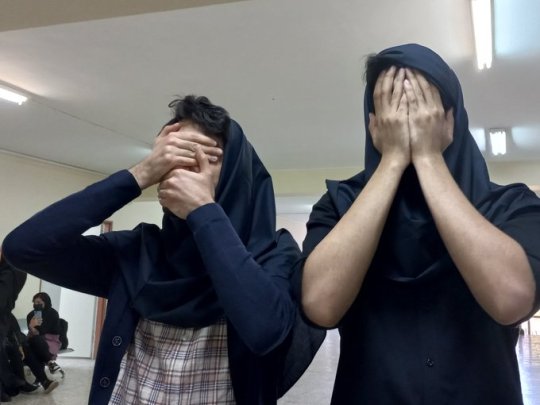

Some men have been doing either this or wearing shorts in public. The former is to ridicule the obligatory dress code and the latter is because wearing shorts in public is forbidden for guys too.
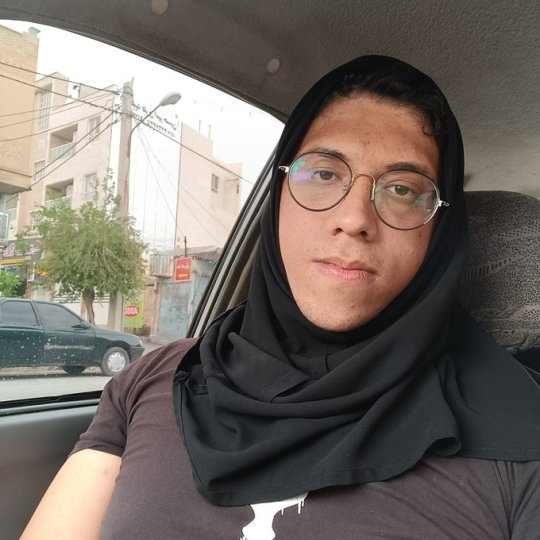
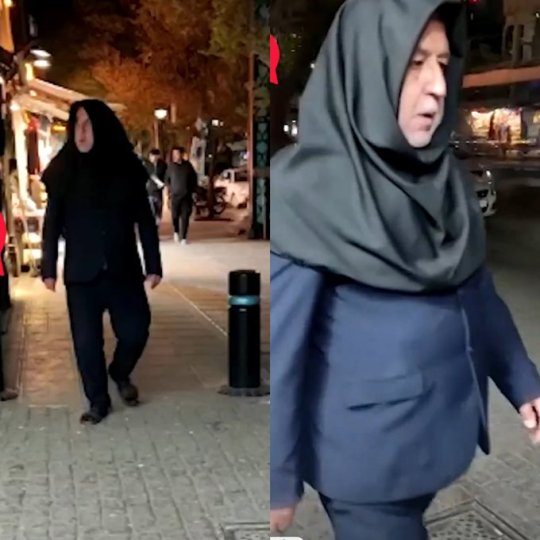

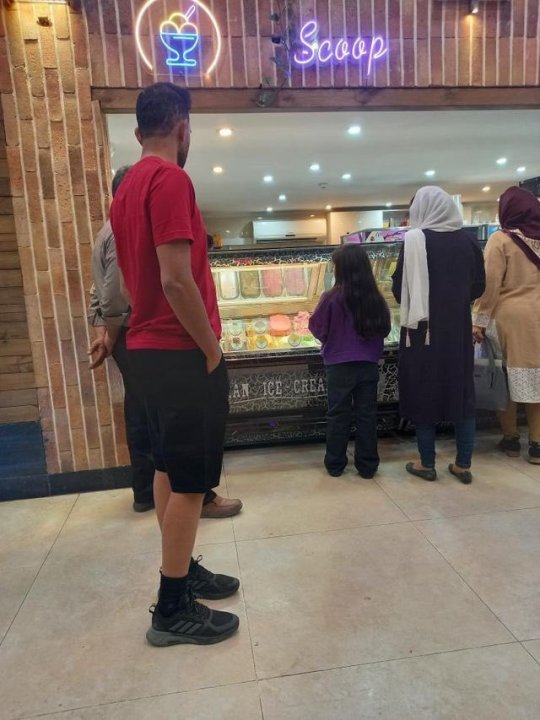
And women not wearing hijab in general. Though hijab is not our only issue, we want a whole new political system, one that is not theocratic or terroristic, hijab is something the regime won't back down from because it's one of their strongest oppressing tools. If they let us win the fight against obligatory hijab, I quote from a regime head, "people keep demanding more changes"!
So to put people against people to enforce the hijab law again, the regime has closed down many businesses (hotels, cafes, malls, bookstores, etc) for welcoming non hijabi female costumers. They have also warned taxi and bus drivers to not let non hijabi women in their vehicles.
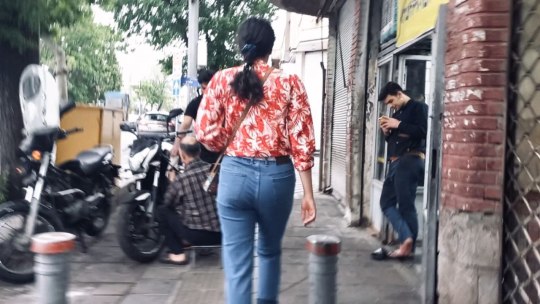
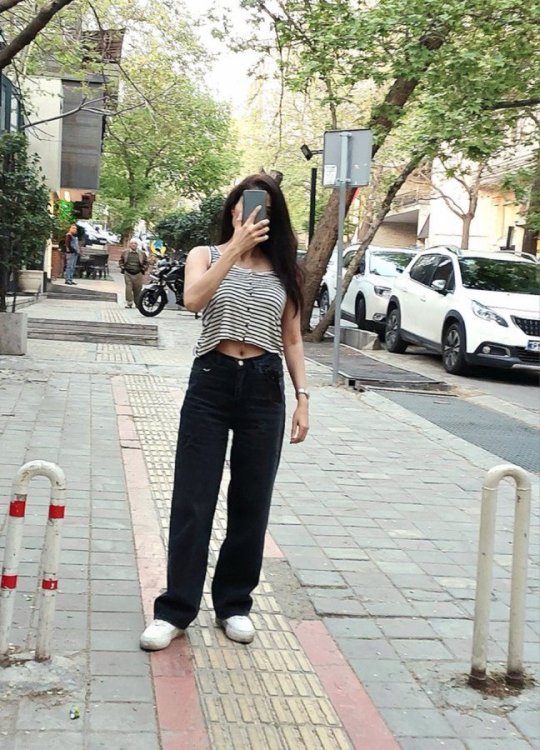
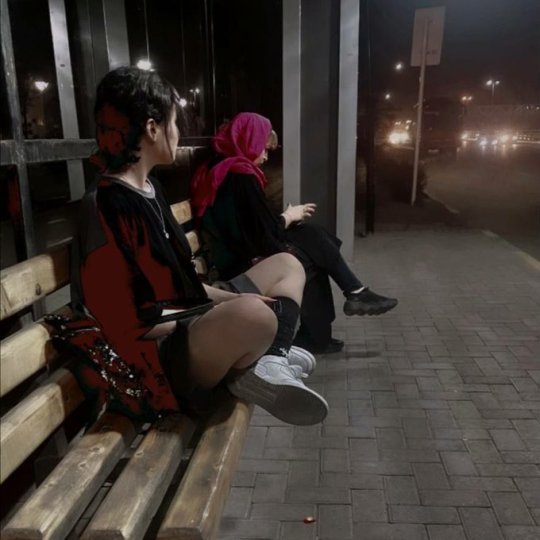
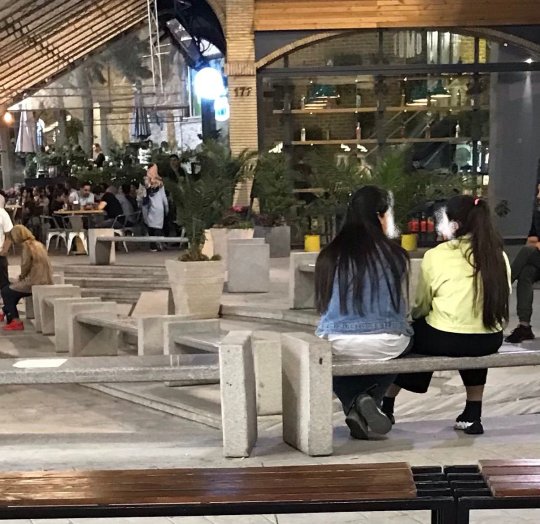
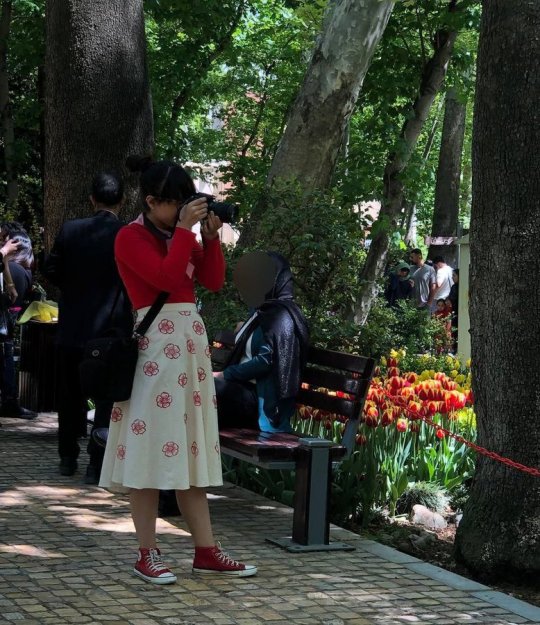

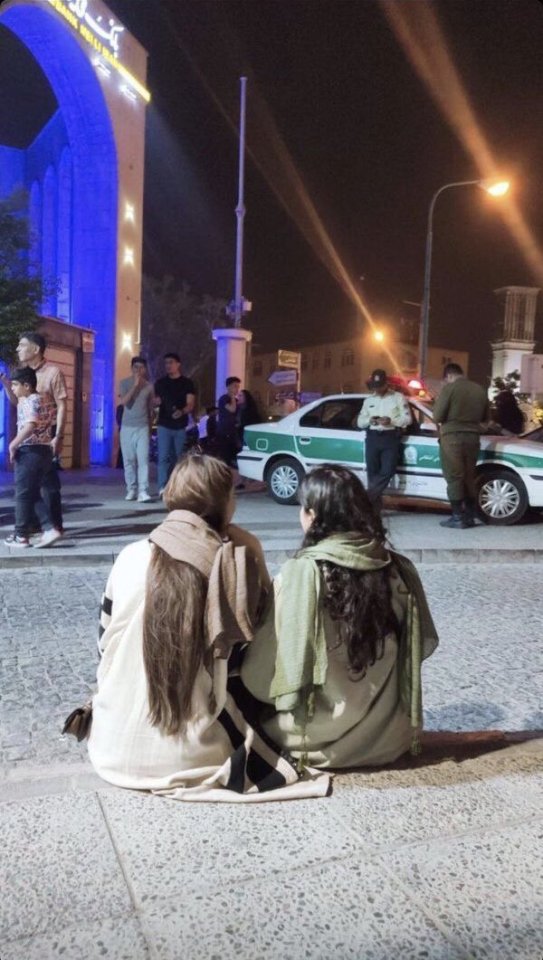


Although not everyone is disobeying the hijab law (some believe in hijab, some don't want to pay the price), the number of women who take the risk and don't wear hijab in Tehran and many other cities is high enough that you feel encouraged to keep doing it.
#iran#iran protests#iran revolution#mahsa amini#jina amini#jin jiyan azadi#women life freedom#politics#human rights#feminism#middle east#women revolution#obligatory hijab#university student#civil disobedience
2K notes
·
View notes
Note
Since you did latina can you do arab that would be so cute plsss i love your fics its my favourite fics i have ever read
AHAH IVE BEEN WAITING FOR THIS!!! *crackles knuckles and rolls neck* it’s my time to shine.
This list has a special place in my heart since I’m Arab. Idk why I didn’t do this sooner but….
here is a list of things I think would happen if Bucky dated an Arab!reader

disclaimer: credits to original creator/poster of image/gif. found on google/Pinterest
1. He would absolutely terrified of your mom and aunts.
You would warn him about them before you brought him home for the first time but nothing could prepare him for awaited him. The moment you stepped foot inside, your mom and aunt were upon him, touching, poking, grabbing, everything. They were all over him as he looked at you with wide eyes that begged to help him. You tried but your mom hit your hand with a sharp “khalas” as she leads him into the kitchen. Your dad is useless and backs away with his hands up when you look to him for help.
“Mami, bi sharafak. Give him some breathing room,” you gently demand as to not turn her attention to you.
Bucky’s gentle smile and even kinder eyes warrant even more commotion from the herd of women around him. They finally let him go after thoroughly interrogating him about everything under the sun and he instantly finds you. Wrapping his arm around you and pressing a kiss to your hair, he whispers to you that you’re not allowed to ever leave him alone with them again. When you ask him why, all he mumbles is something along the lines of “some many questions and the touching.”
“Food?” You ask as a peace offering and he happily accepts it.
2. Whenever he’s around you, he literally doesn’t stop complimenting you.
Maybe it’s your perfume, maybe it’s the way you style your hair, or maybe it’s your outfit that day. No matter what, he is ALWAYS complimenting you.
You have about 40 bottles of perfume but there are few that he loves more and will ask if you can wear them more often. At first, he would just casually mention that he liked how you smelled that day but the longer you’re together, the more obvious he is about it. He goes from asking if you can wear the gold one to straight up picking your perfume out for the day. It’s become a little routine at this point; when you’re getting dressed, he’ll pick something out and help you put it on. You’re perfectly capable of doing it yourself but it’s an excuse to have him close and to feel his hands on you. His favorite and the one he picks the most is the one that your mom got you as a graduation gift. You asked him one day why he liked it so much and he told you that it was what you wore the day you two met. That and it smells like “oranges and summer.”
Bucky is OBSESSED with your hair, maybe more than your perfume collection. It’s usually blown out and styled so he can’t touch it but it’s all over when you leave it natural. Of course he’s a gentleman and will ask if it’s okay to play with it before fully twisting his hand into your curls. They’re almost like a fidget toy for him; he’ll toy with a curl when you’re cuddling on the couch. If you’re in public, he’s gently massaging the base of your neck and playing with the little ringlets that live there. If you need to wash it, he’s right there with all of your products in hand. If you need to put it up, he’s already behind you and gathering your hair for you.
3. If you’re Muslim, he would try so hard to understand your religion.
I genuinely don’t believe that Bucky knows anything about Islam prior to meeting you. It’s possible he met a few Muslims in the 30s and 40s since he lived in Brooklyn but he knows nothing about Islam.
To put it mildly, America is a very interesting place when it comes to the Middle East and Islam and a lot of the information he gets at first is contradictory. When he learns that you’re Arab and also Muslim, he tries to do as much research as he can but ends up getting pissed off and stops. He’s not frustrated due to a lack of understanding, he’s livid that new sources are allowed to say whatever they want and no one stops it.
The following convo is just one example of when this happens:
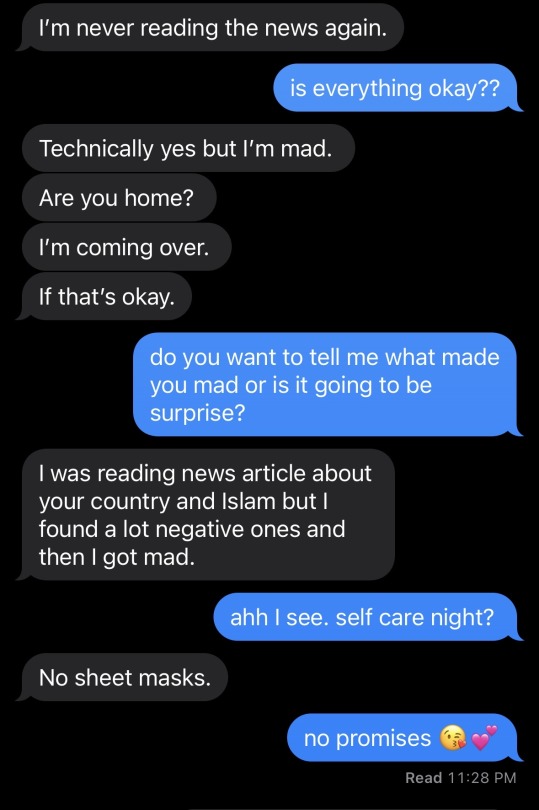
Aside from wanting to never use the internet again, he’d take the time to sit down and talk to you about your different holidays so when they come around so that he understands what’s going on. He’d buy an English translation of the Qur'an so he can read with you. You’ve offered to read yours in English but he’s adamant that he wants his own. It’s adorable really.
I think he would try really hard to learn Arabic so that he can understand Islam better but it’s a very diffcult language to master. What’s even cuter though is watching him study a word and you can see those big beautiful blue eyes scan it over and over again as he thinks about how to say it. You don’t even try to help him as you sit back and shamelessly watch him. Your Arabic lessons usually end with him whispering “تقبرني” (taqburni) against your lips.
#bucky barnes imagine#bucky barnes#bucky barnes x reader#bucky barnes x y/n#bucky barnes x you#bucky barnes fic#marvel imagine#bucky barnes fanfic#Arab reader#Arab reader x Bucky#Arab!reader x Bucky#request#bucky barnes reader insert#marvel
64 notes
·
View notes
Photo

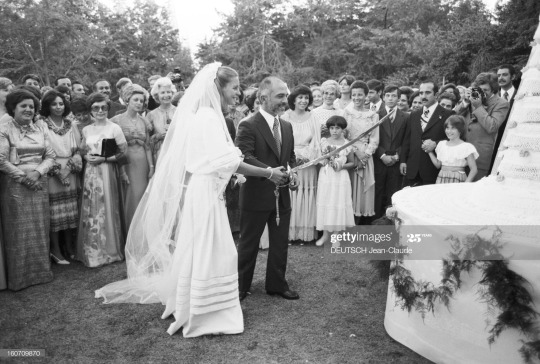


Royal Wedding in Amman | By Rami G. Khouri, June 16, 1978
An American girl became a queen yeaterday as 26-year-old Princeton University architecture graduate Lisa Halaby took the name of Noor al Hussein, the faith of Islam and the hand in marriage of King Hussein, ruler of the Hashemite Kingdom of Jordon.
The new queen's mother was barred from the four-minute ceremony itself - Koranic law dictates that the bride be the only female present - but the new queen beamed radiantly down at her two-inches-shorter, 16-years-older royal husband at a reception afterward attended by some 500 friends and relations. Soft drinks subbed for champagne at the reception, though, as Moslem law again prevailed.
Queen Noor, whom Jordonian officialdom had reffered to earlier as "Moslem Miss Noor Halaby," had converted to her husband's faith. she had been expected to attain the rank of "pricess" because she was not an Arab, but was dubbed his queen by the Jordanian monarch. Only one other of his four wives, the late Queen Alia, a Palestinian, had been so honored.
But Queen Noor's Arab ancestry - her father was of Syrian descent - had been played up by the state-run media since her engagement to the king was announced, and, of course, it is all up to the king as to visit what he wishes to name his wife.
The bride smiling throughout the ceremony and the two-hour reception that followed was dressed in a white Christian Dior wedding gown and had a women band of white flowers holding in her long blond hair in place.
Diamond earrings and bracelets added sparkle to her composure, as she and the king posed for photographers immediately after the wedding ceremony.
Queen Noor - her name means "Light of Hussein" - was visibly settling comfortably into her new role, and she and the king exchanged frequent glances and comments that grinning broadly.
Five hundred guests waited for them on the lawn of the Zahran Palace, home of the queen mother and traditional site of royal marriages. The couple emerged to cut the seventier one-yard-high fruitcake wedding cake with a golden Hashemite sword, and mingled for 10 minutes with the royal family that had gathered to congratulate them.
The casual, happy atmosphere of the occasion was captured decisively when one of the king's young daugthers from a previous marriage rushed up to Queen Noor and exclaimed "I really like your dress," for which she was rewarded with an equally enthusiastic embrace, and a hug and a kiss from the king. Queen Noor had helped design the gown.
The guests included the elite of Jordonian society, the diplomatic corps, government officials, senior officers of the armed forces and selected friends of the new queen. But no foreign guests were to be seen aside from the Halaby family, Mrs. Cyrus Vance and a handful of the queen's friends from the United States. Oneof Hussein's ex-wives, the English-born Princess Muna, was also present. The former Toni Gardner, she now lives in London but returns frequently to Amman where she still has a palace.
Smartly dressed, flag-bearing troops of the Hashmeite horse guard flanked the entrance to the Zahran palace, in Amman's most exclusive residential neighborhood, while the armed forces band played lively music in the background and tough Bedouin security forces got caught up in the general gaiety around and continually preventing photographers from swarming over the royal couple.
The father of Queen Noor, former Pan American Airlines chairman Naheeb Habaly, said "We have feelings of pride, pleasure and some anxiety," and revealed that the king and queen will visit the United States before the end of the year "so she can have an American-style reception in Washington for all our friends in the United States."
The wedding ceremony itself was a traditional all-male affair, with the king and his bride sitting together on a settee flanked by the chief justice of Jordon's highest Islamic court; Crown Prince Hassan and Prince Mohammad, and the bride's father, with his gray business suit and black bow tie.
The king first signed three copies of the marriage contract, and Habaly followed suit, signing in Arabic to the left of the king's signature. The chief justice, Ibrahim Qatan, then recited the couple repeated. The vows derived from the Koran, the Islamic holy book, simply stake that the couple has been married according to the agreements reached between them them in the marriage contract and according to the laws of God and his prophet.
Then, the royal couple, with the king at the wheel of their silver Mercedes 600 limousine, drove out of the palace grounds and off to an undisclosed destination, followed by the usual contingent of two security cars, and the cheers and quiet clapping of the several hundred guests who gathered at the gate to see them off.
There was a festive feeling throughout Amman today, but no special decorations or signs of public celebration, in keeping with the wishes of the newlyweds for a low-key ceremony. Newspapers were filled with notices of congratulations from citizens throughout the country, and some shopfronts and taxicab windows sported large black-and-white pictures of the king and queen. Otherwise, life in the Jordanian capital went on as usual. (Washington Post)
5 notes
·
View notes
Text
Decoding Funeral Etiquette: What Every Guest Needs to Know
Navigating the complexities of funeral etiquette is essential as you pay respects at a funeral, a memorial service, or during the process of funeral planning. Understanding the basic principles, from what flowers to bring as a sign of sympathy to the appropriate attire for a funeral, burial, or cremation service, helps honor the deceased and support those in grief.
This article provides a comprehensive guide to funeral etiquette, including insights on how to express condolences, the significance of different funeral customs, and the dos and don'ts surrounding caskets, coffins, and memorial services. By considering these guidelines, you can approach these solemn occasions with sensitivity and respect.
Understanding Funeral Etiquette: Basic Principles
Importance of Empathy and Respect
Understanding and respecting the emotional state of the bereaved is fundamental in funeral etiquette. Displaying empathy, such as offering comforting words or simply being present, can significantly aid those grieving. It's crucial to approach each situation with sensitivity, acknowledging that this might be one of the most challenging periods in someone's life. Remember, it's not about saying the perfect thing but about showing that you care and respect their feelings and the memory of the deceased.
Social Norms and Expectations
Funeral etiquette also involves adhering to certain social norms and expectations. These include arriving on time, dressing appropriately, and maintaining a demeanor that reflects the solemnity of the occasion. It's important to engage in gestures of respect such as signing the guest book, participating in rituals, and offering condolences to the family, which underscore your support and respect for the bereaved and the deceased.
Cultural and Religious Considerations
Every culture and religion has its specific customs surrounding death. Whether it's the immediate burial practices of Islamic traditions, the shiva in Judaism, or the wearing of white instead of black at Hindu funerals, being aware of these practices can help avoid misunderstandings and display deep respect for the bereaved's cultural and religious sentiments. When in doubt, it's advisable to ask questions discreetly or do prior research to ensure that your actions align with the expected practices.
Deciding What to Wear to a Funeral
Common Attire Guidelines
When you're deciding what to wear to a funeral, it's generally best to opt for conservative and respectful attire. This typically means business-type clothing that wouldn't be out of place in a serious professional setting. For men, a suit with a collared shirt and tie or smart slacks with a sport coat are considered appropriate. Women can choose a suit with a skirt or pants in a dark, solid color, or a conservative dress with a sweater or blazer. It's important to ensure that any skirts or dresses are of an appropriate length, ideally reaching the knees.
Variations Based on Culture and Family Wishes
Funeral attire can vary significantly based on cultural norms and specific requests from the family of the deceased. In many Western cultures, dark colors like black, navy, or gray are standard. However, some families may request more specific attire to reflect the personality or preferences of the deceased, such as asking mourners to wear the favorite color of the person who has passed away. It's also not uncommon for cultural differences to influence attire choices; for example, white is traditionally worn at funerals in Hindu and Sikh cultures.
Appropriate Colors and Styles
While black remains the most traditional choice for funeral attire, other dark colors such as navy, charcoal, or dark green are also acceptable and can be a respectful alternative. It's advisable to avoid bright and flashy colors, as well as overly casual items like jeans and sneakers. The focus should be on subtlety and respect, not standing out. When in doubt, opting for muted tones and simple, unadorned styles will generally be appropriate. If you are uncertain about the dress code, especially if the funeral might have unique elements like a celebration of life service, don't hesitate to ask the family or the funeral director for guidance.
How to Offer Condolences and Support
Choosing the Right Words
Offering condolences sensitively begins with choosing the right words. Simple expressions like "I am so sorry for your loss" or "You and your loved one are in my thoughts and prayers" are universally appreciated and can convey your sympathy without overwhelming the bereaved. Personalize your message based on your relationship with the person; for example, mentioning a cherished memory can show genuine care and connection. Remember, the goal is to express support and acknowledge the loss, not to provide explanations or diminish the pain.
Appropriate Actions and Gestures
Actions often speak louder than words when offering support during a time of grief. Practical gestures like sending a sympathy card, making a phone call, or offering to help with daily tasks can significantly alleviate the stress on the bereaved. Consider specific offers of help, such as preparing meals, assisting with funeral arrangements, or simply being there to listen. These actions demonstrate your commitment to providing support and show that you are there for them in any capacity they need.
The Impact of Presence and Listening
Just being present can be one of the most powerful ways to support someone who is grieving. Your presence at a funeral or memorial service signifies respect and solidarity. Listening is equally important; allowing the bereaved to share their thoughts and feelings without judgment can offer immense relief. Be patient and provide a comforting presence, whether that involves engaging in conversation or sitting in supportive silence. This approach helps the bereaved feel understood and less isolated in their grief.
Guidelines for Bringing Children to Funeral Services
Age Considerations
When deciding whether children should attend a funeral, consider their age and understanding of death. Young children may not grasp the concept of permanence associated with death, which can lead to confusion. For children aged 5 to 7, who start to comprehend the finality of death, attending a funeral can be part of their grieving process and help them say goodbye. Always ensure the decision is age-appropriate and consider the child's emotional maturity.
Preparing Children for What to Expect
It's crucial to prepare children for what they will encounter at a funeral to reduce anxiety. Explain the setting and proceedings of a funeral, including the presence of a casket or urn, and the types of emotions they might observe. Use simple, truthful language to describe the sensory experiences they might have, such as the scent of flowers or the sight of a loved one in a casket. Preparing them for the variety of emotions they will witness, from sadness to laughter, helps normalize the experience.
Behaviors and Activities for Children
Offering children a role in the ceremony can help them engage with the process and express their grief. Suggestions for involvement include reading a poem, singing a song, or participating in a tribute during the service. For younger children, provide quiet activities like drawing or soft toys to comfort them. It's important to give children the option to participate or observe, ensuring they feel safe and supported throughout the event. Always have a trusted adult ready to take them aside for a break if they feel overwhelmed.
After the Funeral: Continuing Support for the Bereaved
Follow-Up and Check-Ins
After the funeral services conclude, it's crucial to continue offering support as the bereaved navigate through their grief. The initial flurry of activities surrounding the funeral may give way to a profound sense of solitude for the bereaved. Regular check-ins can make a significant difference. A simple phone call or message to let them know you're thinking of them can be very comforting. It’s thoughtful to offer specific assistance, such as helping with groceries or inviting them for a coffee or a meal, which can provide both practical help and a reason to step out.
Meaningful Gestures of Support
Small acts of kindness can have a big impact during the extended healing time. Consider sending a "Thinking of You" card a few weeks after the funeral or on the anniversary of the death. These gestures remind the bereaved that they are not alone and that their loss is remembered. Practical support, like dropping off a meal or helping with household chores, can also be invaluable, reducing the day-to-day stress on someone dealing with intense emotional pain.
Remembering Important Dates and Anniversaries
Dates that mark anniversaries, birthdays, and holidays can be particularly challenging for those who are grieving. Reaching out during these times can show enduring support and companionship. A thoughtful note or a call on these significant dates acknowledges the continuing impact of the loss and can help the bereaved feel connected and supported. Sharing memories or stories of the deceased can also be a comforting way to honor their life and help keep their memory alive in the hearts of loved ones.
Read: Repatriation of Human Remains
Conclusion
Navigating the waters of funeral etiquette is more than just adhering to traditions; it's a profound way to express our compassion and respect during times of loss. This guide has traversed the essential aspects of funeral etiquette, from the attire that befits the solemnity of the occasion to the sensitive offering of condolences and support that recognizes the unique pain of bereavement. By embracing these guidelines, we ensure that our presence at these significant moments reflects our deepest respect for the deceased and our heartfelt support for those they leave behind.
The significance of these practices extends beyond the immediate gestures of empathy and respect; they foster a sense of community and shared mourning that is crucial in the healing process. As we continue to support the bereaved in the days and months following the funeral, our actions reaffirm the enduring nature of love and memory. In honoring these traditions and embracing the role of comforter with grace, we not only pay our respects but also contribute to the collective journey of healing and remembrance.
FAQs
1. What are the guidelines for seating at a funeral?
At a funeral, seating is typically arranged by closeness to the deceased. Immediate family members and close friends are seated at the front of the venue. Other attendees, such as additional close family and friends, are seated just behind this primary group.
2. Who should attend a funeral?
Anyone who knew the deceased or is close to the grieving family can attend a funeral. It is not typically an invite-only event. Attending a funeral is a way to honor the deceased's life and express support for their loved ones.
3. What behaviors are inappropriate at a funeral?
It is highly inappropriate to bring alcohol or drugs to a funeral or to attend while under the influence. Such actions are considered a significant sign of disrespect to both the deceased and other mourners.
4. Where should acquaintances sit during a funeral service?
Acquaintances and co-workers of the deceased should sit towards the rear of the service area. This allows closer family and friends to sit at the front and near the front, maintaining a respectful distance.
5 notes
·
View notes
Text
Sultan Qaboos Grand Mosque: A Must-Visit Landmark in Muscat
The Sultan Qaboos Grand Mosque is one of Muscat’s most iconic landmarks, renowned for its breathtaking architecture and deep cultural significance. This architectural marvel attracts thousands of tourists each year, making it a key highlight of any Muscat city tour. Whether you are passionate about Islamic architecture, interested in cultural exploration, or simply seeking a serene atmosphere, the Grand Mosque promises an unforgettable experience.

Why Visit Sultan Qaboos Grand Mosque?
This majestic mosque reflects Oman’s Islamic traditions and rich heritage, serving as a symbol of peace and spirituality. In this guide, we explore why the mosque is a must-see destination in Muscat, provide travel details, and share essential visitor tips to enhance your experience.
Architectural Grandeur of Sultan Qaboos Grand Mosque
Five Minarets Representing the Pillars of Islam
The mosque features five towering minarets, each symbolizing the Five Pillars of Islam. These elegant structures frame the vast central courtyard, enhancing the mosque’s impressive scale and spiritual significance.
Exquisite Islamic Design
Built from pristine sandstone, the Sultan Qaboos Grand Mosque boasts stunning domes, intricate carvings, and artistic calligraphy. Every aspect of its design reflects a harmonious blend of traditional and modern Islamic architecture, making it a highlight of any Muscat tour.
Magnificent Interior of the Mosque
A Grand Prayer Hall for 20,000 Worshippers
With a capacity of over 20,000 people, including 750 women in a dedicated prayer gallery, the mosque is among the largest in the world. The airy interiors and grand dome create a tranquil and awe-inspiring atmosphere for both worshippers and visitors.
Handwoven Persian Carpet – A Masterpiece
One of the most remarkable features inside the mosque is the enormous Persian carpet in the main prayer hall. Covering an area of 4,345 square meters and weighing nearly 21 tons, it took 600 artisans over four years to complete this stunning piece, making it one of the largest hand woven carpets in the world.
World’s Second-Largest Chandelier
Suspended from the main dome is a magnificent 14-meter chandelier adorned with Swarovski crystals. Weighing 8.5 tons, this dazzling structure illuminates the prayer hall, adding to the mosque’s ethereal beauty.
Intricate Calligraphy and Artistic Details
Islamic calligraphy embellishes the walls and ceilings, blending seamlessly with geometric patterns and traditional motifs. These artistic details make the Grand Mosque a true masterpiece of Islamic craftsmanship.

Visiting Sultan Qaboos Grand Mosque
Opening Hours for Visitors
The mosque is open to visitors, including non-Muslims, from 8:00 AM to 11:00 AM, Saturday to Thursday. This allows tourists to explore its architectural and spiritual significance without disrupting prayer times. Fridays are reserved for worshippers.
Entry Guidelines for Non-Muslims
The Sultan Qaboos Grand Mosque warmly welcomes non-Muslim visitors, offering an opportunity to learn about Omani culture and Islamic traditions. Visitors should observe respectful behavior, including speaking quietly and walking gently inside prayer halls.
Dress Code for Visitors
Since the mosque is a place of worship, visitors are required to adhere to a modest dress code:
Women: Long-sleeved, loose-fitting attire covering wrists and ankles, along with a headscarf to cover the hair.
Men: Long pants and shirts with sleeves are required.
Are Pants Allowed?
Yes! Long pants are acceptable for both men and women. While jeans are permitted in Oman, it is best to avoid ripped, tight, or overly casual styles when visiting religious sites.
Is Sultan Qaboos Grand Mosque Family-Friendly?
Yes, families with children are welcome to visit the mosque. However, parents should ensure that children remain calm and respectful of the mosque’s peaceful ambiance. Visiting in the early morning is recommended when the site is less crowded.

Sultan Qaboos Grand Mosque at Night
While the mosque is closed to tourists at night, its illuminated exterior offers a breathtaking view. The glowing minarets and domes against the Muscat skyline create a mesmerizing sight, making an evening drive or stroll around the mosque a must-do in any Muscat tour package.
Plan Your Visit with Oman Safari Tours
For a seamless and enriching experience, book a guided tour with Oman Safari Tours. Our expert guides will provide in-depth insights into the mosque’s history, architecture, and cultural significance. Explore the Sultan Qaboos Grand Mosque as part of a comprehensive Muscat city tour, and discover the beauty of Oman’s heritage firsthand.
Why the Sultan Qaboos Grand Mosque Belongs on Your Travel Bucket List
The Sultan Qaboos Grand Mosque is not just a place of worship but a symbol of Oman’s artistic and cultural excellence. Its stunning architecture, intricate design, and tranquil atmosphere make it one of Muscat’s most captivating attractions. Plan your visit early in the morning to fully appreciate its beauty, and let Oman Safari Tours guide you through an unforgettable experience.
Reserve your next adventure with Oman Safari Tours and explore the best of Muscat!
0 notes
Text
The Elegance of Abayas for Women in the UK
Abayas, a symbol of modesty and elegance, have become a staple in the wardrobes of many women across the UK. Sumayah, a trusted name in modest fashion, offers an exquisite collection of abayas tailored to modern tastes. This article explores their significance and how they cater to contemporary fashion needs, with a special focus on Abayas for Women in the UK. As more women in the UK embrace modest fashion, Sumayah stands out by offering stylish and versatile abayas that seamlessly blend traditional values with modern trends, ensuring every woman feels confident and fashionable.
What is an Abaya
An abaya is a long, flowing robe traditionally worn by Muslim women. It is often black but now comes in a variety of colours and designs to cater to diverse preferences. Sumayah’s abayas blend tradition with innovation, offering options for every style.
History and Significance
The abaya originates from the Arabian Peninsula and is deeply rooted in Islamic culture. It represents modesty while allowing women to express their personal style. Sumayah honors this heritage by crafting abayas that embody both cultural significance and modern elegance.
Why Abayas Are Popular in the UK
Cultural and Religious Importance
With a growing Muslim population, abayas cater to women who wish to adhere to Islamic dress codes while living in a multicultural society. Sumayah supports this diversity by offering a wide range of designs that cater to varying preferences.
Modest Fashion Movement
Modest fashion has gained global attention, and abayas have become a key part of this trend, appreciated for their versatility and elegance. Sumayah leads the way in this movement, providing abayas that are both stylish and respectful of modesty.
Styling Abayas for Various Occasions
Abayas can be styled for different occasions:
Casual Wear: Pair with a simple hijab for a comfortable yet chic look.
Formal Events: Opt for embellished abayas with matching accessories from Sumayah’s exclusive collection.
Shop at Sumayah for Elegance and Quality
Explore Sumayah’s exclusive range of abayas, combining tradition and contemporary style. Each piece is crafted with care to ensure quality and elegance. Visit our website today to find your perfect look.
Final Thoughts
Abayas are more than a garment; they are a representation of culture, modesty, and modern fashion. With their growing popularity in the UK, they continue to inspire women to embrace both tradition and style. Choose Sumayah for abayas that truly stand out.
Explore the latest styles and find your perfect abaya at Sumayah's website: https://sumayah.co.uk/ or Shop Now: https://sumayah.co.uk/collections/.
Follow Sumayah for more inspiration and updates on Instagram: https://www.instagram.com/sumayah and TikTok: https://www.tiktok.com/@by.sumayah.
1 note
·
View note
Text
Hypeladies | Explosive Fashion Style Guide for Dubai 2025
Explosive Fashion Style Guide for Dubai: A Style Guide for Travelers in 2025
Dubai is a vibrant city where women’s fashion reflects a unique mix of tradition and modernity. Whether you’re a traveler, expat, or fashion enthusiast, here’s an in-depth guide to help you understand women’s fashion style in Dubai. Dubai, a dazzling metropolis, effortlessly combines traditional Arabian culture with a cosmopolitan lifestyle. As a traveler, understanding fashion, dressing etiquette, and cultural norms is crucial for ensuring a comfortable and respectful visit. Whether you're exploring the towering Burj Khalifa, wandering through the spice souks, or attending glamorous parties, here’s everything you need to know about fashion style in Dubai and appropriate dressing.
Understanding Dubai’s Dress Code for Travelers
Fashion Style Guide for Dubai 2025 Dubai Clothing Rules Dubai is known for its modern vibe but maintains modest cultural traditions rooted in Islamic values. The dress code reflects this, requiring visitors to strike a balance between stylish and respectful dressing. Here are some general rules: - Avoid overly revealing clothing in public spaces like malls, souks, and restaurants. - Keep shoulders and knees covered when visiting government buildings or mosques. - Swimwear is allowed only at beaches, pools, and water parks, not in public streets. - Choose breathable fabrics like cotton or linen, as Dubai’s weather can be hot, especially in summer. White Dubai Dress Code While white outfits symbolize purity and elegance, they are also practical for Dubai's heat. Many tourists and locals opt for light-colored clothing during the day to stay cool.
Traditional Women’s Fashion Style Guide for Dubai
Abaya Dubai Style The abaya is a central part of traditional Emirati fashion for women. While it remains modest and functional, the modern Dubai abaya design offers creative variations: - Classic Black Abaya: Timeless and elegant, it often features subtle embroidery or embellishments. - Pleated Abaya Dubai: Adds a contemporary twist with structured pleats, perfect for women who want a modern yet modest look. - New Dubai Abaya Design: Designers incorporate vibrant colors, unique cuts, and trendy details to cater to diverse preferences. - Dubai Style Abaya Online: Online platforms showcase trendy abayas, making it convenient for travelers to find stylish options. Burqa Style in Dubai Although the burqa is less commonly worn, some women in Dubai incorporate it as a cultural choice or for formal occasions. Modern burqas often feature softer fabrics and intricate lace designs.
Modern Women’s Style in Dubai
Dubai embraces a cosmopolitan atmosphere, and women have the freedom to explore a wide range of fashion styles while adhering to the city’s clothing rules. Here are some key trends and styles:

Modern Women’s Style in Dubai Dubai Fashion Style Dresses - Maxi Dresses: Perfect for the city’s hot climate, maxi dresses are both fashionable and modest. Choose lightweight fabrics and bold prints for a chic look. - Corset Dresses: A popular trend, corset-style dresses can be worn with shawls or cardigans for a modest touch. - Gowns and Evening Wear: Dubai’s upscale nightlife calls for elegant gowns. Look for Dubai gown styles with long sleeves, high necklines, or floor-length hemlines. Street Style Fashion in Dubai Dubai’s street fashion is all about balancing comfort and luxury. Women often mix high-end brands with casual pieces: - Flowy midi skirts paired with button-down blouses. - Chic jumpsuits accessorized with statement jewelry. - Stylish linen pants and oversized blazers for a polished yet relaxed look.
Hijab and Niqab Fashion in Dubai
For women who wear the hijab or niqab, Dubai offers a variety of fashionable options: - Dubai Hijab Design: Hijabs come in breathable fabrics like silk and chiffon, often adorned with delicate prints or embroidery. - Dubai Style Niqab: Modern niqabs feature sleek cuts and soft materials for comfort. - Modest Fashion: Pair hijabs with Dubai abaya designs or loose-fitting dresses for a seamless look.
Outfit Ideas for Travelers
Dubai Women’s Style Women visiting Dubai have endless options to dress stylishly while adhering to cultural norms: - Corset dress Dubai: Choose modest corset-style dresses that don’t expose too much skin. - Dubai gown style: Perfect for fine dining or events; opt for gowns with high necklines and long sleeves. - Maxi dresses: Flowing, breathable, and always appropriate.
Fashion Tips for Women Travelers in Dubai

Modern Women’s Style in Dubai What to Pack When packing for your Dubai trip, keep these essentials in mind: - Daytime Outfits: Lightweight tunics, wide-leg trousers, or flowy dresses are ideal for sightseeing. - Evening Wear: Semi-formal dresses or gowns with minimal skin exposure work well for dining or nightlife. - Beachwear: Swimsuits and bikinis are acceptable at private hotel beaches or pools, but always carry a cover-up for public spaces. How to Dress for Different Occasions - Exploring the City: Stick to modest outfits like maxi dresses, skirts, or capris paired with T-shirts or blouses. - Visiting Mosques: Women must cover their hair, arms, and legs. A scarf and long-sleeved maxi dress are ideal. - Shopping or Dining: Opt for stylish casual or smart-casual outfits such as a jumpsuit or tailored pants.
Fashion Events and Shopping for Women in Dubai
Dubai is a shopping paradise, with a vast array of stores catering to women’s fashion. Shopping for Traditional Attire - Dubai Fashion Stores: Deira and Satwa are hubs for abayas, hijabs, and modest wear. - Burqa Style in Dubai Online Shopping: Platforms like Namshi and Noon offer traditional attire with a modern twist. Luxury Fashion - Fashion Avenue Dubai Mall: Houses global luxury brands like Gucci, Chanel, and Valentino, alongside traditional Emirati designs. - Pernia's Pop-Up Dubai: A unique event showcasing South Asian couture and jewelry.
Dressing According to Cultural Norms
Modesty is Key While Dubai is tolerant of different styles, it’s essential to respect cultural expectations: - Avoid sheer or overly tight clothing in public. - Cover shoulders and knees when visiting public areas like malls, souks, or cultural landmarks. - Swimwear is acceptable at private beaches but not in public areas. Tips for Comfort - Opt for fabrics like cotton, linen, or jersey for breathability. - Carry a lightweight scarf or shawl to cover up when needed.
Popular Women’s Fashion Designers in Dubai
Dubai is home to several talented designers blending tradition with innovation: - Huda Al Nuaimi: Known for her intricate embroidery and modern abayas. - Rami Al Ali: A celebrated designer specializing in glamorous evening gowns. - Amato Couture: Offers avant-garde designs favored by celebrities.
Fashion Insights for Women’s Business Attire
For women traveling to Dubai for work, the business dress code is formal and professional: - Dresses and skirts should be knee-length or longer. - Blouses and shirts should have sleeves and avoid plunging necklines. - Pantsuits or tailored separates are ideal for meetings and conferences.
What Dresses to Wear in Dubai: Tips for Travelers
When visiting Dubai, travelers should prioritize comfort and modesty. Lightweight fabrics and breathable materials are ideal for the warm climate. Here are some tips: - For sightseeing: Opt for maxi dresses or flowy skirts. - For malls and restaurants: Semi-formal attire like tailored trousers or elegant blouses works well. - For beach outings: Modest swimsuits or kaftans are recommended.
Conclusion
Dubai offers endless possibilities for women to explore fashion, from traditional abayas to high-end evening wear. By blending modesty with modern trends, you can embrace Dubai’s unique fashion culture while respecting its customs. Whether you’re shopping for Dubai hijab designs, attending a fashion event, or simply exploring the city, you’ll find the perfect balance of style and comfort. Read the full article
0 notes
Text
Why Choose Modest Islamic Clothing from Hikmahboutique?
Are you searching for stylish and comfortable modest Islamic clothing that aligns with your values? Modest Islamic clothing combines elegance, functionality, and tradition, making it perfect for modern Muslims. Here's why hikmahboutique should be your go-to destination:
Wide Variety of Options: From abayas to hijabs, modest Islamic clothing offers diverse styles for all occasions, including casual wear, workwear, and formal attire.
Quality and Comfort: Hikmahboutique ensures that every piece is crafted with high-quality materials to provide comfort and durability while maintaining modesty.
Trendy and Timeless Designs: Modest Islamic clothing doesn’t have to be plain. With elegant cuts, patterns, and contemporary styles, you can express your individuality effortlessly.
Inclusive Sizing: Hikmahboutique caters to all body types, offering inclusive sizes to help everyone feel confident and beautiful.
Affordable Pricing: Shopping for modest Islamic clothing doesn’t have to break the bank. Hikmahboutique provides competitive prices to suit every budget.
Ethically Made: Supporting ethical and sustainable practices, hikmahboutique ensures that its clothing reflects your values in every stitch.
Whether you're dressing for a special occasion or enhancing your everyday wardrobe, modest Islamic clothing from hikmahboutique offers a perfect blend of tradition and modernity.
Shop with hikmahboutique today to find clothing that reflects your faith, values, and personal style. Elevate your wardrobe with modest Islamic clothing that empowers and inspires!
0 notes
Text
Embrace Elegance with Traditional Muslim Dress and Modern Pakistani Suit Designs
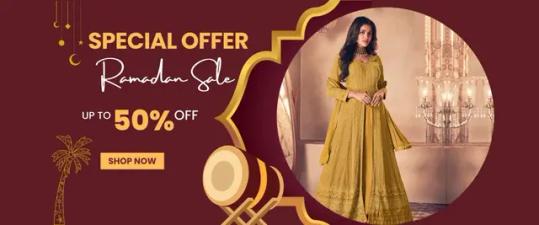
In the world of fashion, Islamic clothing has always stood out for its timeless elegance, modesty, and cultural richness. Whether you're looking for a traditional Muslim dress a casual Islamic dressing style, or a modern Pakistani suit design, there’s something for everyone. At IslamicFashion.in, we celebrate the beauty of Islamic attire, offering a wide range of options to suit every occasion. Let’s dive into the latest trends and styles that are redefining modest fashion.
Traditional Muslim Dress: A Timeless Classic The traditional Muslim dress is a symbol of grace and modesty. From flowing abayas to intricately designed hijabs, these outfits are perfect for those who want to stay true to their roots while embracing sophistication. Pair a classic black abaya with a beautifully embroidered hijab for a look that’s both modest and stylish.
Casual Islamic Dressing Style: Comfort Meets Fashion
For everyday wear, the casual Islamic dressing style is a go-to choice. Think loose-fitting tunics, comfortable maxi dresses, and stylish palazzos. These outfits are perfect for running errands, attending casual gatherings, or simply relaxing at home. Add a touch of modernity with a trendy casual Islamic dressing style that incorporates bold colors and contemporary cuts.
Salwar Kameez: A Versatile Wardrobe Essential
The salwar kameez is a staple in every Muslim woman’s wardrobe. Whether you prefer a black dress Pakistani simple design or a Pakistani light purple salwar kameez, this outfit is perfect for both formal and casual occasions. The simplicity of a black salwar kameez exudes elegance, while a light purple ensemble adds a pop of color to your look.
Modern Pakistani Suit Design: Redefining Modest Fashion
If you’re looking to make a statement, opt for a modern Pakistani suit design. These outfits blend traditional craftsmanship with contemporary trends, featuring intricate embroidery, bold prints, and unique cuts. Whether it’s a wedding, Eid celebration, or a festive gathering, a modern Pakistani suit will ensure you stand out in style.
Trendy Casual Islamic Dressing Style: Stay Fashion-Forward
Fashion is ever-evolving, and so is Islamic clothing. The trendy casual Islamic dressing style is all about combining modesty with modern trends. Experiment with layered outfits, asymmetrical cuts, and bold accessories to create a look that’s uniquely yours.
Why Choose IslamicFashion.in?
At IslamicFashion.in, we understand the importance of modesty without compromising on style. Our collection includes everything from traditional Muslim dresses to modern Pakistani suit designs, ensuring you find the perfect outfit for every occasion. Explore our range of salwar kameez, abayas, hijabs, and more, and discover the beauty of Islamic fashion.
Conclusion
Whether you’re drawn to the simplicity of a black dress Pakistani simple design or the vibrancy of a Pakistani light purple salwar kameez , Islamic fashion offers endless possibilities. Embrace the elegance of traditional Muslim dress and the innovation of modern Pakistani suit designs with IslamicFashion.in. Visit us today and redefine your wardrobe with modest yet trendy outfits that celebrate your unique style.
#islam traditional clothing#islamic traditional dress#muslim traditional wear#muslim traditional clothing#branding#fashion
0 notes
Text
What to Wear in Egypt: A Guide for Travelers
Some guides you need to consider while planning for a trip to Egypt to have a better experience of how the country is like include the culture of the place. Egypt as a country with a very old history and oriented to an Islamic turnover traditionally pays much attention to the conception of the outfit. So, again, although fashion there differs rather considerably from what is honest in the countries of the West, having understood what it is proper to put on in Egypt you will not only respect traditions of this exceptional country but also will have much more convenient and interesting vacation.
Currently, Egypt has officially practiced the religion of Islam with the larger part of the population being Islam followers and denomination being Sunni. This cultural backdrop defines fashion most especially for women. Modern Egyptian women still one practice their hair, arms and knees covered when they wear their dresses. This type of clothing is a basic element of the culture and Americans or European travelers should take it into consideration when touring around the iconic Egyptian landmarks.
But at the same time it is necessary to mention that Egypt is a country of contrasts. It should be added that the dress code, nevertheless, can be more relaxed in large Egyptian cities such as Cairo or Alexandria: it is significantly so in wealthy districts or in those places which are oriented to tourists. Men may dress in smarter ways which are more closer to the western world’s dress code but all in all dressing remains more conservative, especially when planning to visit a mosque or villages etc.
Women, in particular, must wear appropriate coverings over their bodies, not only because they incorporate the local visual perception into their outfits, but also because this step will prevent unwanted attention. Admittedly, the attention can be unwanted – this is especially true for Western women, who can get whistled at or at least get comments if they wear something too revealing. Indeed, in such cases it is advisable for women to forego crop tops t-shirts and shorts and annoying looks altogether. However avoid wearing dresses that expose the belly or lack dresses that expose the shoulders, arms and knees. A simple but elegant attire, perfect for such weather, requires ethic assured decency – a loose-sleeved blouse paired with trousers or a maxi-skirt type of dress will suffice.
However, if you are in a resort or visiting coastal travellers’ places like Sharm El-Sheikh or Hurghada then there are quite lenient measures. Here, as you will find many foreign visitors, people dress casually going to the beach or any swimming pool wearing swimsuits, short or sundresses. You will feel comfortable to dress lightly and formally in most hotels and resorts. Still when you come out I must advise that you dress appropriately as you find it in some of these areas you visit because not everybody accepts apostle Johns nakedness.
More on the same, men intending to tour Egypt should also ensure that they dress appropriately responding to Egypt’s conservative culture. Do not wear shorts at public places and when touring around religious places or villages. Lounge style long pants, light color trousers with ankle socks and full sleeved trouser will help you to feel comfortable and also keep you away from the norms of the region.
When it comes to clothing, sensible shoes are very important when walking around Egypt’s archaeological sites. Each trip encompasses a tour over a territory with pyramids, tombs, and temples, so your feet are in motion for many hours; recommended footwear is closed shoes, best of all – sandals or sport shoes. Sandals can be worn during beach or hotel occasions but not during excursions.
Lastly and for the record, the weather in Egypt is quite warm most times especially in the summer, but how revealing can one get? It’s best to dress formally for this part of the world since cotton and linen fabrics are breathable ones that do not make you sweat. It also turns useful when you are a woman needing to cover your shoulders when entering a mosque or any other religious place.
0 notes
Text
Tailored Elegance: Muslim Dressmaking Services for Men in Charlotte
When it comes to traditional and modern Islamic fashion, Muslim dressmaking services for men in Charlotte provide a unique opportunity to create custom pieces that reflect cultural heritage while ensuring comfort, style, and perfect fit. Whether for daily wear, prayer, special occasions, or weddings, custom-made garments allow Muslim men to express their individual style and embrace their faith with confidence. Let’s explore the benefits of Muslim dressmaking services and how they cater to the diverse fashion needs of the Muslim community in Charlotte.
The Importance of Tailored Muslim Garments
A Perfect Fit for Comfort and Style One of the primary reasons for opting for Muslim dressmaking services for men is achieving a perfect fit. Unlike ready-made garments, which often vary in size and shape, tailored clothing is crafted to the exact measurements of the individual. This ensures that the garment fits comfortably and flatters the body, allowing for freedom of movement, especially during prayers or while engaging in daily activities. Muslim dressmakers in Charlotte can create garments that enhance both style and comfort, giving you the perfect fit for every occasion.
Reflecting Personal Style and Faith Muslim men’s fashion is not limited to a single style; it can be versatile and deeply personal. Custom dressmaking services allow men to choose the fabrics, colors, and styles that resonate with their personality while adhering to Islamic dress codes. Whether you prefer a traditional thobe, a modern kufi, or a contemporary fusion of Islamic attire, a tailor can bring your vision to life. Tailoring ensures that each garment is not only a reflection of your faith but also a testament to your personal style.
Quality and Craftsmanship Muslim dressmaking services for men in Charlotte offer high-quality craftsmanship. Skilled dressmakers use premium fabrics and expert sewing techniques to create garments that are durable and long-lasting. Custom-made clothing is crafted with precision, ensuring that every stitch, seam, and hem is completed to the highest standard. By investing in tailored garments, Muslim men can enjoy high-quality attire that will remain in excellent condition for years to come.
Cultural Significance and Tradition Islamic attire holds cultural and religious significance, with garments like the thobe, shalwar kameez, and jubbah being staples in many Muslim communities. Dressmaking services for Muslim men not only ensure that these garments are stylish and comfortable but also that they maintain their cultural significance. Tailored garments celebrate Islamic heritage and provide men with a way to embrace their traditions while adapting to modern life. Whether for daily wear, Eid celebrations, or other religious gatherings, a custom-made piece can make these occasions even more special.
Muslim Dressmaking Services for Men in Charlotte: What to Expect
Charlotte has become a diverse and vibrant hub with a growing Muslim population, and this demand for tailored Islamic clothing has led to an increase in dressmaking services that specialize in Muslim men’s fashion. These services cater to a wide variety of needs, offering customized pieces for daily wear, prayer attire, and formal occasions. Here’s what you can expect when seeking Muslim dressmaking services in Charlotte:
Personalized Consultation When you approach a dressmaker, the process typically begins with a consultation. During this consultation, you’ll discuss your specific needs and style preferences. Whether you are looking for a thobe, suit, or casual wear, the tailor will take your measurements, listen to your fabric and design preferences, and offer expert advice on fabric types, colors, and style options that align with your vision.
Fabric Selection and Design Choosing the right fabric is a crucial part of the dressmaking process. Muslim dressmaking services in Charlotte offer a wide range of fabrics, from breathable cottons and linens perfect for hot weather to luxurious silks for formal events. The tailor will help you select the ideal fabric that not only suits the occasion but also provides comfort and durability. You’ll also have the opportunity to discuss any special design elements, such as embroidery, cuff styles, and collar options, ensuring your garment is one-of-a-kind.
Expert Tailoring and Craftsmanship Once you’ve chosen your fabric and design, the dressmaker will begin constructing your garment. The tailoring process involves precise measurements and expert sewing techniques to ensure that the final product fits perfectly. The dressmaker will carefully craft your piece, taking time to ensure that every detail, from the stitching to the finishing touches, is done to perfection.
Fittings and Adjustments A fitting session is a crucial part of the process, as it ensures that the garment fits perfectly. If needed, the dressmaker will make adjustments to the garment to ensure it meets your expectations. After the final fitting, you will receive your completed piece, ready to wear for any occasion.
Why Choose Muslim Dressmaking Services in Charlotte?
Cultural Sensitivity and Understanding Tailors who specialize in Muslim men’s fashion have a deep understanding of cultural and religious needs. They know how to create garments that meet Islamic dress requirements while offering modern, stylish designs. They also understand the importance of modesty in Islamic fashion and ensure that all garments are designed to maintain this principle.
Convenience and Personalization Having a garment custom-made locally means that you can work closely with your tailor and receive personalized attention throughout the process. This ensures that you get exactly what you want and that the garment fits perfectly. Additionally, local tailors can provide timely alterations, making it easier to have a wardrobe that always fits.
Versatility for Every Occasion Whether you need clothing for daily wear, religious events, or weddings, Muslim dressmaking services in Charlotte offer versatile options. Custom tailoring ensures that you’re ready for any occasion, from prayer to celebration, with garments that are both functional and stylish.
Conclusion
Muslim dressmaking services for men in Charlotte offer a unique and personalized approach to Islamic fashion. By choosing a custom-made garment, you are investing in quality, comfort, and style that meets your cultural and religious needs. Whether you're looking for a traditional garment or a more contemporary look, these services ensure that you can express your faith with confidence and style.
0 notes
Text

✨ Discover the chic Solid High Neck Long Sleeve Abayas, blending Dubai elegance with ruffled kaftan style. Perfect for modest fashion lovers, this Muslim dress is ideal for both casual wear and special events. Inspired by Turkey’s modern Islamic clothing. Shop now on AliExpress! 🛍️
Click Below to get it
Solid High Neck Long Sleeve Abaya
#AbayaFashion #DubaiStyle #AliExpressFinds #MuslimDress #Kaftan #ModestFashion #IslamicClothing #ElegantAbayas #RuffledKaftan #TurkeyFashion #ModestWear #AliExpressDeals
#abayafashion#fashion#chic fashion#abaya#luxury abaya#fashionblogger#chic style#fashionista#outfit#women fashion#fall outfits#fall fashion#autumn style#hijab#burqa#purdah#beachwear#kaftan#women clothing#aliexpresslook#aliexpress#onlineshopping#stylishouterwear#colorfulstyle#slimfitstyle
0 notes
Text
The Elegance of the Abaya Kimono with Hijab: A Perfect Blend of Tradition and Style
In the world of modest fashion, few outfits embody grace and versatility as seamlessly as the Abaya Kimono with Hijab. This modern take on traditional attire combines the flowing beauty of the abaya with the relaxed elegance of the kimono, offering women a stylish yet modest option for a variety of occasions.
At Mary & Mary, we celebrate the harmonious blend of tradition and contemporary fashion, offering a stunning collection of Abaya Kimonos with Hijabs that cater to every woman’s sense of style and cultural values.
What is an Abaya Kimono?
The Abaya Kimono is an innovative fusion of two timeless garments: the abaya, a traditional long cloak worn by women in many Muslim-majority countries, and the kimono, a Japanese garment known for its wide sleeves and straight-line silhouette. This combination brings together the elegance of both designs, resulting in a unique, versatile outfit perfect for modern modest fashion enthusiasts.
The Abaya Kimono is characterized by its loose, comfortable fit and flowing fabric, making it a beautiful choice for both formal and casual settings. Paired with a hijab, this outfit provides a complete, stylish look that maintains modesty while allowing room for personal expression.
Why Choose an Abaya Kimono with Hijab?
There are several reasons why the Abaya Kimono with Hijab has become a favorite among modest fashion lovers:
Versatility: The Abaya Kimono can be worn for a wide range of occasions, from casual daytime outings to formal evening events. Its loose fit and flowing design make it comfortable for everyday wear, while its stylish appearance ensures you look chic no matter the occasion.
Cultural Expression: This outfit honors both the modesty and traditions of Islamic fashion while incorporating the graceful lines of a kimono, creating a bridge between cultures. It’s a beautiful representation of how fashion can respect and celebrate cultural heritage.
Elegance in Modesty: The Abaya Kimono provides full coverage, making it ideal for women seeking modest fashion that doesn’t compromise on elegance. Paired with a matching or contrasting hijab, the outfit is effortlessly chic and sophisticated.
Comfortable and Breathable: Made from light, breathable fabrics, the Abaya Kimono ensures you remain comfortable even in warmer climates. The loose fit also allows freedom of movement, making it perfect for busy days or long events.
Styling Your Abaya Kimono with Hijab
The beauty of the Abaya Kimono with Hijab lies in its flexibility when it comes to styling. Here are some tips to help you create the perfect look:
Casual Daywear: Opt for a simple, neutral-colored Abaya Kimono paired with a soft, lightweight hijab. Add a statement belt to cinch the waist and create a more structured silhouette.
Evening Glamour: For more formal occasions, choose an Abaya Kimono with intricate detailing or embroidery. Pair it with a luxurious silk hijab for an elevated, elegant look.
Layering: Since the Abaya Kimono is usually open at the front, it can be worn over a variety of outfits, from long dresses to slim-fit trousers and tops, providing endless styling possibilities.
Our Commitment to Quality
At Mary & Mary, we understand that modest fashion should not only be stylish but also made with the highest quality materials. Our Abaya Kimono with Hijab collection is crafted with care, ensuring that every piece is both fashionable and durable. From the finest fabrics to attention to detail in design, we offer a range of Abaya Kimonos that suit different preferences, from minimalist styles to more elaborate, embroidered options.
Embrace Timeless Elegance with Mary & Mary
Whether you’re looking for a go-to outfit for everyday wear or a stunning ensemble for a special occasion, the Abaya Kimono with Hijab is the perfect choice. At Mary & Mary, we are proud to offer a collection that honors tradition while embracing modern fashion trends, helping you look and feel your best, always.
Explore our latest collection and find the perfect Abaya Kimono with Hijab to suit your style and occasion. Let’s celebrate the beauty of modest fashion together!
0 notes
Text
The Significance and Style of the Islamic Abaya
The Islamic abaya is a cornerstone of modest fashion, representing both a cultural tradition and a modern fashion statement. This garment, widely recognized for its simplicity and elegance, plays a crucial role in the daily lives of many women around the world. As modesty continues to influence fashion trends, the Islamic abaya remains a timeless and versatile piece that balances tradition with contemporary style.
What is an Islamic Abaya?
The islamic abaya is a traditional garment worn by women as an outer layer to provide full coverage while adhering to Islamic principles of modesty. Typically, it is a long, flowing robe that covers the body from the shoulders down to the ankles. The abaya is designed to be loose-fitting, allowing for ease of movement and ensuring that the wearer is modestly dressed according to Islamic guidelines.
Traditionally, the Islamic abaya is crafted from simple, solid-colored fabrics such as black or dark tones. However, modern iterations may feature a variety of materials, colors, and embellishments, reflecting the diverse tastes and preferences of women today. The garment can be paired with a hijab or shawl to complete the modest look, providing additional coverage and complementing the overall outfit.
Versatility and Modern Adaptations
One of the key advantages of the Islamic abaya is its versatility. It can be adapted for various occasions, from everyday wear to special events. For casual settings, a basic abaya in a neutral color or simple design offers comfort and practicality. It can be paired with casual footwear and minimal accessories for a relaxed, yet polished appearance.
For more formal occasions, the Islamic abaya can be styled with elegant fabrics such as silk or satin, and adorned with intricate embroidery, beading, or lace. These modern adaptations elevate the traditional garment, making it suitable for weddings, religious gatherings, and other special events. The versatility of the abaya ensures that it remains relevant across different settings and fashion contexts.
Fashion Trends and Contemporary Styles
The Islamic abaya has evolved significantly over the years, reflecting contemporary fashion trends while maintaining its core principles of modesty. Designers have embraced innovative fabrics, colors, and designs to create abayas that cater to modern tastes. From flowing silhouettes with unique cuts to vibrant prints and textures, contemporary abayas offer a fresh take on traditional modest wear.
Additionally, the integration of high-quality materials and sophisticated detailing has contributed to the abaya’s appeal. Many modern abayas feature luxurious fabrics, such as chiffon, velvet, and georgette, which add a touch of elegance and refinement. The use of bold colors, patterns, and artistic embellishments allows women to express their personal style while staying true to the values of modesty.
Customization and Personalization
Another significant aspect of the Islamic abaya is the opportunity for customization. Many boutiques and online stores offer bespoke services, allowing women to select specific fabrics, colors, and design features. This customization ensures that each abaya reflects the wearer’s individual preferences and style, making it a unique and personal garment.
Conclusion
The Islamic abaya remains a fundamental element of modest fashion, celebrated for its elegance, versatility, and adherence to Islamic principles. Its ability to adapt to modern fashion trends while maintaining traditional values makes it a cherished garment for many women. Whether worn for everyday purposes or special occasions, the Islamic abaya continues to represent a blend of timeless style and contemporary flair, embodying both cultural significance and modern sophistication.
1 note
·
View note
Text
Exploring the Elegance and Diversity of Abaya in Australia

The abaya is more than just a garment; it is a symbol of modesty, grace, and cultural heritage. In recent years, the popularity of abayas has transcended borders, finding a prominent place in the wardrobes of women across Australia. This article delves into the rich tapestry of abayas in Australia, exploring their cultural significance, the diverse styles available, and the growing market that caters to this elegant form of attire.
The Cultural Significance of the Abaya
In many cultures, the abaya is revered as a traditional dress that embodies modesty and respect. Originating from the Middle East, the abaya has a profound cultural and religious significance, particularly in Islamic communities. It serves as a symbol of a woman's devotion and piety, often worn in conjunction with the hijab. In Australia, the abaya has been embraced not only by Muslim women but also by those who appreciate its elegance and versatility.
Diverse Styles and Trends in Abaya Fashion
The Australian fashion landscape has seen a significant evolution in abaya styles, reflecting both traditional elements and contemporary trends. From classic black abayas to vibrant, embellished designs, there is a wide array of choices for every preference and occasion.
Traditional Black Abayas: The timeless black abaya remains a staple, known for its simplicity and elegance. It is often adorned with subtle embroidery or lace details, adding a touch of sophistication.
Embroidered and Embellished Abayas: For those who prefer a more ornate look, embroidered and embellished abayas are popular choices. These garments feature intricate patterns, beadwork, and sequins, making them ideal for special occasions and celebrations.
Modern and Minimalistic Abayas: The rise of modern fashion has brought minimalistic abayas into the spotlight. These designs focus on clean lines and understated elegance, often incorporating neutral tones and high-quality fabrics.
Seasonal and Occasion-Specific Abayas: In Australia, where the climate varies greatly, there is a growing demand for seasonal abayas. Lighter fabrics such as chiffon and crepe are favored in warmer months, while thicker materials like wool and velvet are preferred in winter. Additionally, special occasion abayas, including those for weddings and festive events, are increasingly popular.
Where to Buy Abayas in Australia
The demand for abayas in Australia has led to a burgeoning market, with numerous retailers and designers offering a diverse range of styles. Here are some popular options for purchasing abayas:
Online Retailers: With the convenience of online shopping, many women in Australia turn to e-commerce platforms for their abaya needs. Websites like Urban Culture Online provide a wide selection of abayas, from traditional to contemporary styles.
Boutique Stores: For a more personalized shopping experience, boutique stores in major cities like Sydney and Melbourne offer curated collections of high-quality abayas. These stores often feature exclusive designs and provide tailored fitting services.
Designer Collections: Australian designers are increasingly creating their own abaya collections, blending traditional elements with modern aesthetics. These designer abayas are often crafted with premium materials and exquisite craftsmanship, making them a favorite among fashion-forward women.
The Growing Popularity of Abayas in Australia
The increasing popularity of abayas in Australia can be attributed to several factors. Firstly, the multicultural nature of Australian society has led to a greater appreciation for diverse cultural attire. As a result, abayas are worn not only by Muslim women but also by those who enjoy experimenting with different styles and fashion trends.
Secondly, the versatility of the abaya makes it a practical and stylish choice for various occasions. Whether worn casually or for formal events, abayas offer comfort and elegance. The adaptability of the abaya to different seasons and climates also contributes to its appeal.
The Future of Abaya Fashion in Australia
The future of abaya fashion in Australia looks promising, with an increasing number of designers and retailers catering to this growing market. As fashion continues to evolve, we can expect to see more innovative designs that blend traditional elements with contemporary trends. Moreover, the rise of social media and online influencers has played a significant role in popularizing abaya fashion, showcasing the versatility and beauty of this garment to a global audience.
In conclusion, the abaya has become an integral part of Australia's fashion landscape, celebrated for its elegance, modesty, and cultural significance. Whether you are looking for a traditional black abaya or a modern, embellished design, there is something for everyone in the diverse world of abayas in Australia.
0 notes